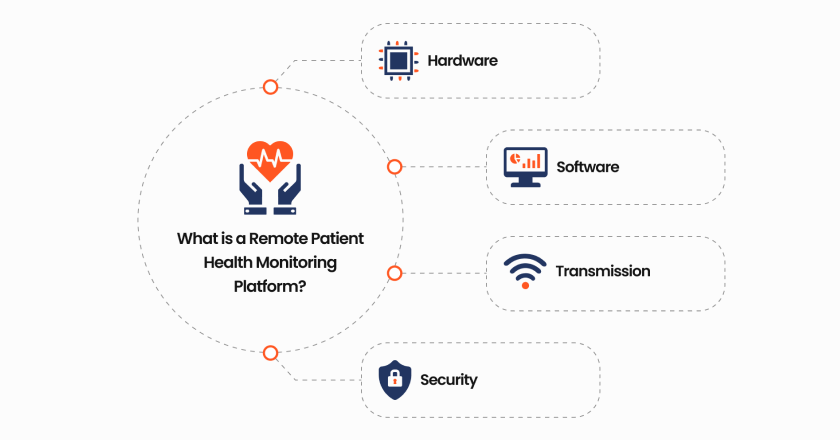Comprehensive Software for Remote Patient Monitoring: Improve Patient Treatment
Comprehensive Software for Remote Patient Monitoring: Improve Patient Treatment
Blog Article
The Future of Healthcare: Remote Client Keeping Track Of Simplified
As health care remains to advance, one area that holds tremendous promise is remote individual tracking. The principle of simplifying this process through technical improvements is improving the means care is provided and obtained. With a concentrate on improving individual outcomes and enhancing medical care delivery, remote monitoring is poised to change the sector. By discovering the advantages, technical developments, and future fads in this field, we can get valuable insights into the transformative potential of remote patient surveillance.
Benefits of Remote Patient Surveillance
Remote client surveillance offers a wide variety of advantages for both healthcare service providers and people alike. Furthermore, remote person monitoring improves the general high quality of care by supplying a more comprehensive and alternative view of clients' health and wellness status past conventional in-person brows through.
In addition, remote individual monitoring can lead to enhanced patient outcomes and complete satisfaction. Remote monitoring can lower the need for regular medical facility brows through, reducing healthcare prices for both carriers and clients.
Innovation Driving Remote Surveillance
In the world of modern healthcare, technical developments play a pivotal role in driving the advancement and efficiency of remote person surveillance. The integration of innovative technologies such as wearable tools, mobile applications, and cloud-based systems has revolutionized the means health care companies remotely monitor and handle patient health and wellness - best remote patient monitoring software. These modern technologies allow continuous real-time tracking of essential signs, medication adherence, and other essential wellness information, enabling for prompt interventions and customized care strategies
One secret technology driving remote monitoring is the Internet of Points (IoT), which makes it possible for smooth connection between clinical gadgets and healthcare systems. IoT devices such as smartwatches and cordless sensing units accumulate and transmit person data to central systems, assisting in remote surveillance from anywhere in the world. Expert system (AI) and artificial intelligence formulas better improve remote monitoring by examining vast amounts of patient data to detect patterns, forecast wellness patterns, and sharp medical care companies to potential concerns.
Effect on Healthcare Shipment
With the assimilation of sophisticated innovations driving remote individual tracking, the impact on medical care delivery is becoming increasingly profound and transformative. Remote individual tracking enables doctor to use even more proactive and individualized treatment to patients, bring about improved health results and decreased medical facility admissions. By remotely tracking important indications, signs and symptoms, and medication adherence, medical care experts can interfere early, stopping issues and boosting the general high quality of treatment.
Furthermore, remote surveillance boosts access to medical care solutions, specifically for people in underserved or rural locations. People can receive constant monitoring and support from their homes, removing the requirement for regular in-person check outs. This not just conserves time and reduces costs for both patients and health care facilities yet likewise decreases the risk of direct exposure to transmittable illness, an important consideration in the present medical care landscape.
Additionally, remote patient tracking allows doctor to far better assign resources and prioritize care based upon real-time information. By recognizing high-risk patients and intervening immediately, healthcare shipment becomes a lot more reliable and effective, inevitably bring about a more sustainable and patient-centered healthcare system.
Improving Client End Results

Additionally, RPM allows for positive monitoring of persistent problems, reducing the likelihood of severe exacerbations and medical facility readmissions. Patients benefit go now from raised comfort and comfort, as they can obtain care in their own homes while staying attached to their medical care providers. This constant tracking not just improves patient contentment however also fosters a feeling of empowerment and interaction in their own health management.
Future Trends in Remote Tracking
Accepting innovative innovations in remote person surveillance is forming the future landscape of healthcare shipment. The future patterns in remote monitoring are anticipated to revolutionize the means health care is given, making it much more reliable and patient-centric. One considerable pattern is the increased usage of wearable tools and sensing units to accumulate real-time data, enabling healthcare providers to keep an eye on patients constantly without the need for frequent in-person brows through. These devices can track important indicators, medicine adherence, and task degrees, supplying a comprehensive sight of the client's wellness condition.

Furthermore, telehealth systems are becoming a lot more advanced, permitting digital appointments, remote diagnosis, and remote person keeping an eye on all in one incorporated system (best remote patient monitoring software). This alternative technique to remote surveillance is streamlining medical care delivery, boosting patient contentment, and eventually, improving overall top quality of you can find out more care
Verdict
To conclude, remote individual tracking offers numerous benefits in healthcare distribution, driven by improvements in modern technology. It has the possible to enhance patient results additional reading and transform the means health care is supplied. Future fads in remote monitoring will remain to shape the landscape of health care, offering chances for more personalized and reliable individual care.
Remote person monitoring provides a wide range of advantages for both medical care carriers and individuals alike. Furthermore, remote person surveillance boosts the total top quality of care by providing a much more thorough and all natural view of people' health and wellness condition beyond traditional in-person check outs.
In addition, remote client tracking can lead to enhanced patient end results and fulfillment. Remote patient monitoring enables healthcare service providers to offer even more positive and individualized care to individuals, leading to improved wellness outcomes and minimized healthcare facility admissions. Remote person surveillance (RPM) plays a substantial function in boosting individual results by giving continual, real-time data that enables health care suppliers to intervene immediately and readjust therapy strategies as required.
Report this page